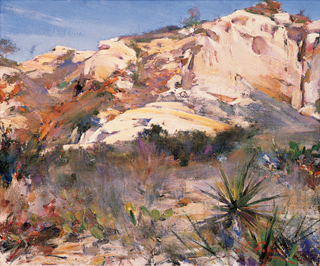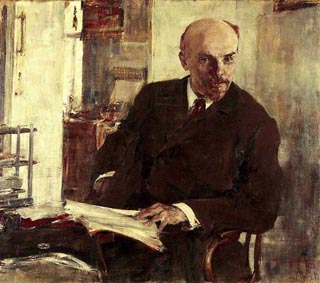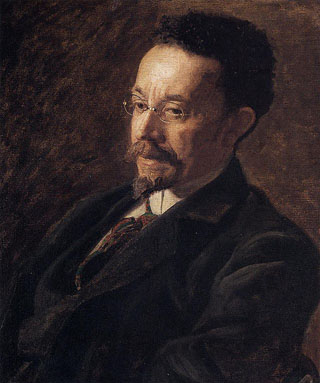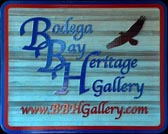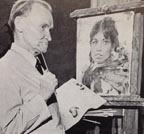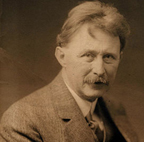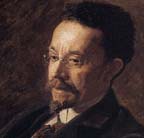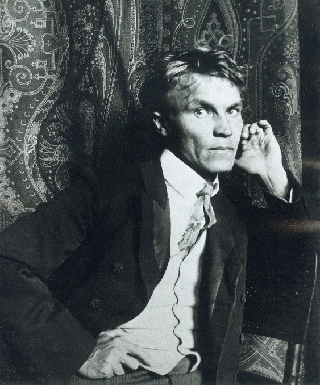
Nicolai Fechin, Photo Portrait |
After his paintings were exhibited at the Grand Central Galleries, he was noticed by California Desert painter and New York cartoonist Clyde Forsythe. Due in part because of Forsythe's encouragement, Fechin
moved West, making Taos, NM, his new home.
The cultural and geographic differences between Kazan, Russia and Taos, New Mexico couldn't be further apart, but Nicolai Fechin managed to call both places home. In Taos, he followed followed the same path he forged in Russia, painting revealing portraits of native people.
|
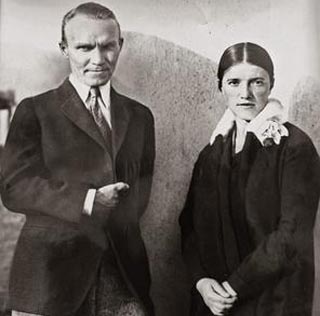
Nicolai and Alexandra Fechin in Taos, 1928 |
From Taos, he traveled to Southern California and made trips across the Pacific to Indonesia and to Bali. Near the end of his life, he bought a home in Santa Monica where he died in 1955.
In the late 1930's, he spent a winter painting in Palm Springs. There, he enjoyed the company of a prestigious fun-loving group of American desert painters.
He became fast friends with one of his hosts, artist John W. Hilton. Hilton's humble home at Valerie Corners in Thermal, California, had become a favorite hang-out for this unlikely fraternity, including Maynard Dixon, Jimmy Swinnerton, and Clyde Forsythe along with LA Times editor Ed Ainsworth.
|
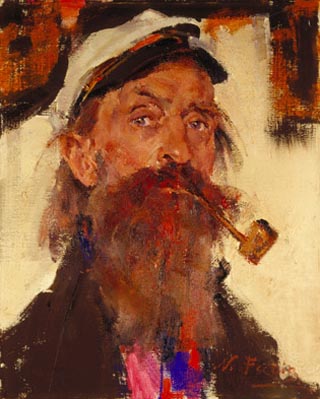 Barge Captain Barge Captain |
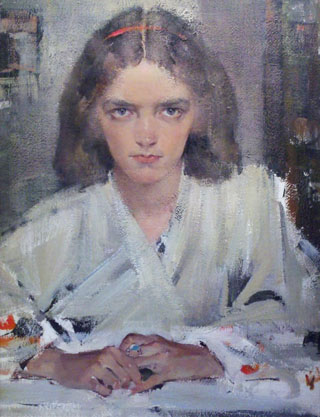
Eya in Judo Gi |
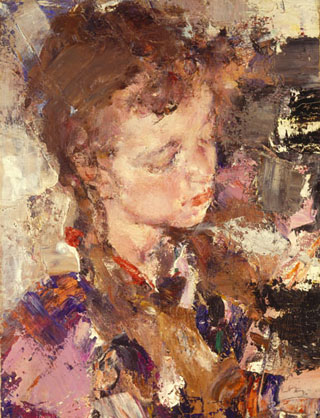
Portrait of a Girl,
Untitled |
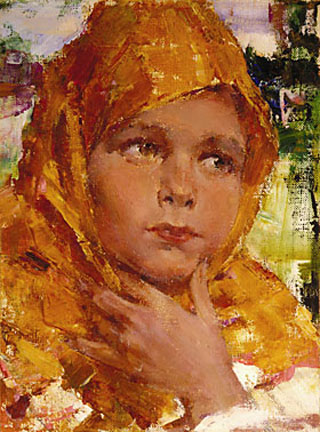
Girl in Orange Shawl |
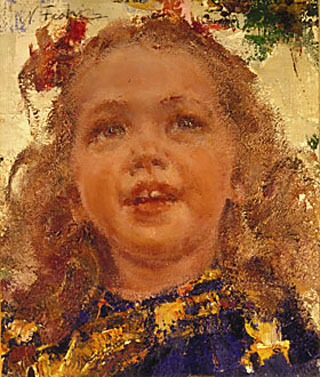
Nikki Ruppert |
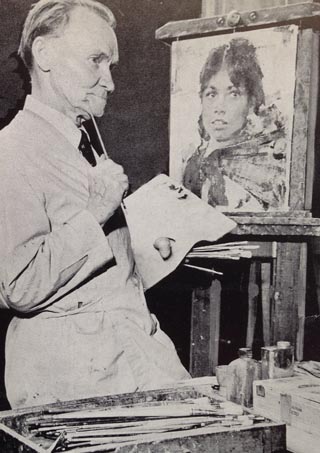
Nicolai Fechin at Easel from
Painters of the Desert by Ed Ainsworth, 1960 |
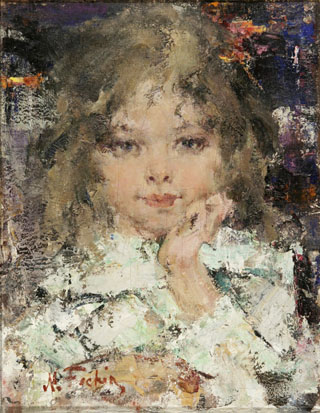
Portrait of a Girl |
Following are excerpts from Painters of the Desert, Ed Ainsworth, 1960 ...
"Nicolai Fechin, he found the desert's soul ... His technique certainly ranks, in form and artistry, with the creations of Leonardo da Vinci. Yet Leonardo, basking under Mediterranean skies, never encountered the upheavals and tragedies which catapulted Fechin from his Russian homeland to the new and different realm in which he was compelled to orient himself all over again."
"For thirteen years, from the dawn until dark, he stood before an easel striving for the mastery of color, form and techniques demanded by
|
the rigorous taskmasters of the Imperial Academy of Art under the direct supervision of the Court of Czar Nicholas. Not until his thirteenth year in the academy was he permitted to paint on his own."
"Then came the great calamities ... World War I and the Bolshevik Revolution, bloodshed everywhere. For seven years, Fechin lived amid famine and misery in the gloomy forests of the Volga. In rare moments when he could paint, he used tempera as oil paints were a luxury."
|
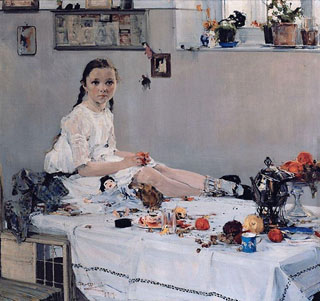
Portrait of Varya Adoratskaya |
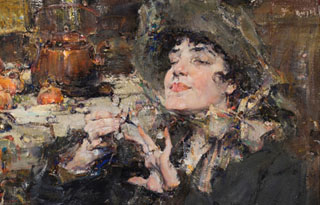
Lady with Manicure |
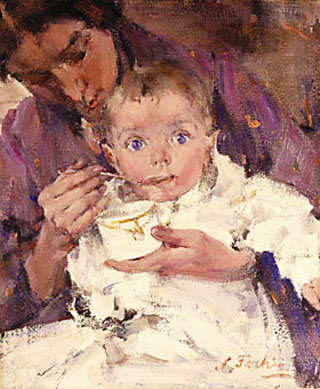
Mother and Child, Wife and daughter Alexandra and Eya |
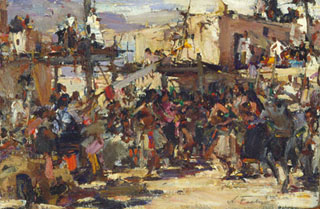 Indians Dancing Indians Dancing |
"Disease took his father and mother. He himself almost died from pneumonia brought on by privation."
"Then at last ... to America. ... Fechin had to start all over again here. He was unable to speak English. He possessed no money. All he had was the artistic ability within him. In those first months in New York, a strange chain of events ... brought his works to be exhibited at the Grand Central Galleries. His work impressed two people in particular. One was John Burnham, a Chicago art collector and painter, and the other, Clyde Forsythe, the cartoonist of "Joe Jinks" and "Dynamite Dunn" and the "Way Out West" and also a Western painter, then sojourning in the East."
|
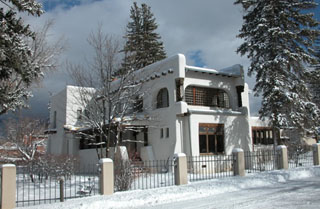
The Fechins' home in snow, NM |
"Through Forsythe's interest and sponsorship, Fechin was able to make invaluable contacts in the West. But Fechin was not interested in land booms or migrations. He was fascinated, instead, by the land beyond boundaries of the cities, by the native Indians, by the soft spoken descendants of the Spanish dons in the desert country."
"Around the Salton Sea, in the mountains above San Bernardino and Redlands, and on the Mojave Desert the freshness and quiet of Early California still prevailed. Burnham took Fechin camping into these remote realms where an almost primeval simplicity spread its enchantment."
"Finally, he moved West. In Taos, in the immemorial Indian village beyond Santa Fe, New Mexico, he settled, reveling in the immense spaces, the unbelievable brilliance of the atmosphere, the patient plodding Indians, the red, yellow and dun cliffs and mountains."
"When not painting, Fechin enjoyed fishing in the upper reaches of the Rio Grande, one of his favorite recreations. During this period of relative stability, Fechin suffered grievously from personal troubles. Driven by them, he sought surcease of spirit by travels in Mexico and in the South Seas where he painted avidly the extraordinary faces of natives on far-flung islands, and tarried for a long time amid the flamboyant colorings of Bali. Always though, the desert beckoned him."
|
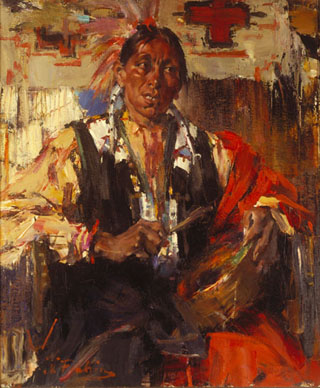
Joe with a Drum |
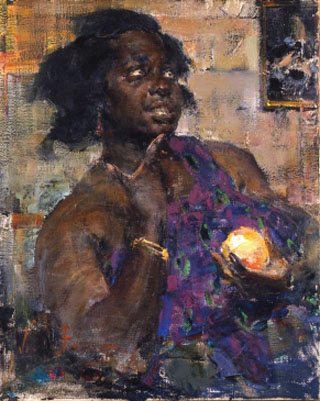
Negro Girl with an Orange |
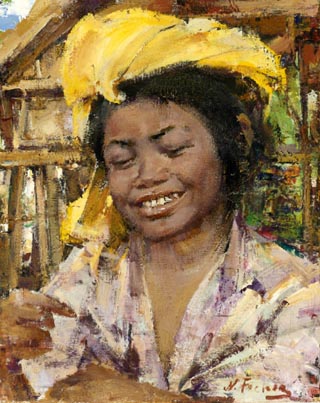
Balinese Girl |
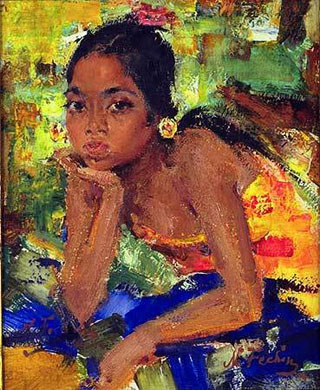
Bali |
"During his enjoyable trips to Palm Springs to visit John Burnham, he would join with the artist's group, including Maynard Dixon, Jimmy Swinnerton and Clyde Forsythe, that would go down to Painter John Hilton's house at Thermal for sessions of talk and guitar music or companionable painting forays into the Mecca Hills or Box Canyon."
In her book The Man Who Captured Sunshine, Katherine Ainsworth writes of the friendship between Nicolai Fechin and John Hilton. "Fechin hated to drive, in fact, probably had never learned, and requested John to drive him to scenic places and to the Indians he knew so well. In exchange, Fechin offered to criticize Hilton's work.
"He was a stern task setter," recalled Hilton. "Fechin was a small intense man with steely, penetrating blue eyes. It was as though he possessed an inner smoldering fire of creativity and those eyes looked keenly into another person's soul and all shoddiness was burned away. With Nicolai, a person's petty meannesses and false pretenses shrank and disappeared."
"To be with Nicolai Fechin was a priceless opportunity and I dropped everything I could to be with him. The first time he went through all my stuff, and I had painted like mad after Maynard Dixon had culled out most of my poor paintings, I nearly died because there were many which were salable. I couldn't help but protest weakly. 'Nicolai,' I said, 'if you destroy all of these, I shall go broke.'"
|
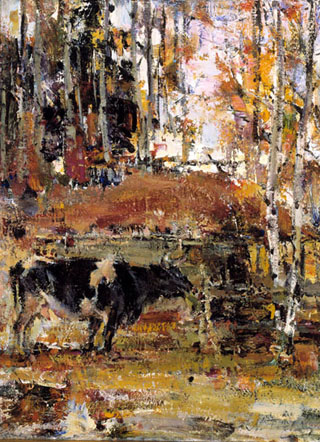
Cows and Aspens, National Cowboy Museum, Tulsa |
| California Impressionist George Gardner Symons 1861-1930 |
George Gardner Symons was born in Chicago during the Civil War. He attended the Art Institute of Chicago where he met his life long friend and studio partner, William Wendt. He and Wendt traveled throughout Europe. Symons studied in London, Paris and Munich. Upon returning to the United States, he changed his last name from Simon to Symons in an effort to avoid antisemitism.
Symons exhibited often in New York with the best American painters of his day. After working as a commercial artist in Chicago, he established a studio in Laguna Beach with William Wendt. He visited California often, but maintained his primary studio in Brooklyn, New York, and often painted in Colerain, Massachusetts.
|
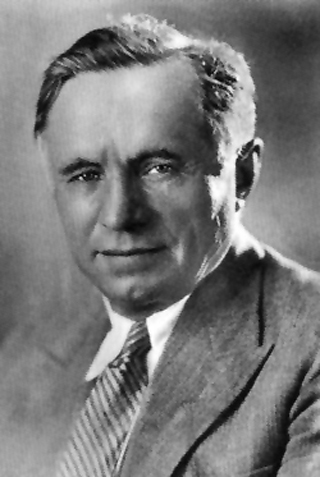
Symon's friend William Wendt, Photo Portrait |
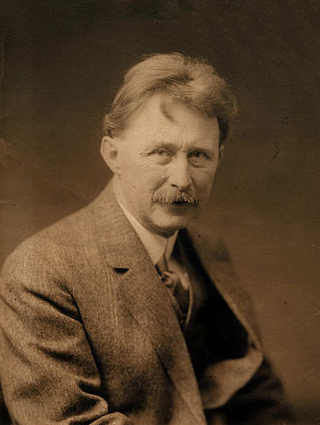
George Gardner Symons, Photo Portrait |
Symons style combined elements of Realism and Impressionism. He is best known for his winter landscapes of rural Massachusetts but loved painting plein air in California. As early as 1896, both Symons and William Wendt were in the avant-garde, bringing new impressionism techniques to interpret the landscapes and light of Malibu Rancho near Los Angeles. In 1898, the pair painted for a time in Cornwall, England.
|
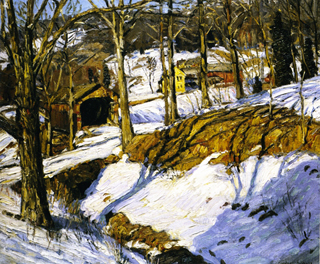
Covered Bridge |
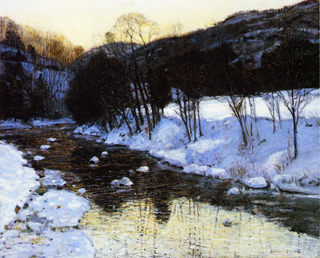
Dusk's Palette |
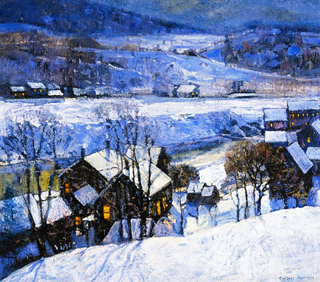
Evening in the Berkshires |
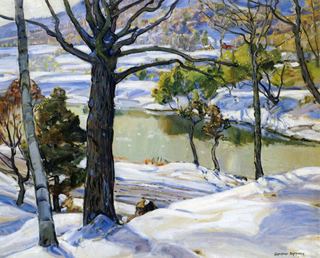
Lone Oak |
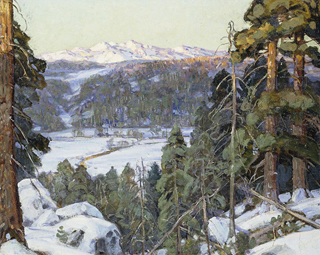
Pines in Winter |
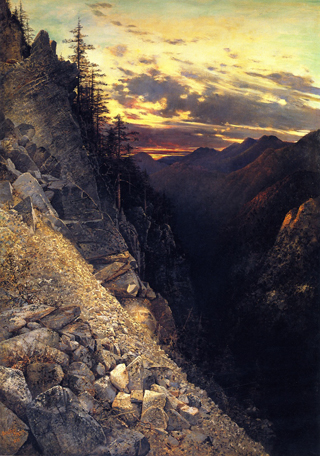
Canyon at Granite Gate |
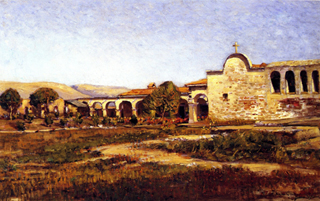
Mission San Juan Capistrano |
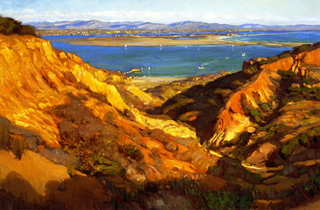
Coronado Island |
Impressionism was just beginning to make inroads into America in the 1890's, encountering much the same headwinds it had encountered in France. The established artists of the time who had been rigidly trained in drawing and composition could not adjust to accept impressionism's bright colors nor tolerate its interest in light effects over their beloved dark emotional works.
But Symons and Wendt proceeded and the Southern California landscape was eminently well suited as a location for impressionist paintings. The soft colors and shimmering atmospheric conditions offered by Southern California begged to be painted. On occasion, he would travel East to Arizona, doing desert landscapes, and he enjoyed doing scenes of the Grand Canyon.
|
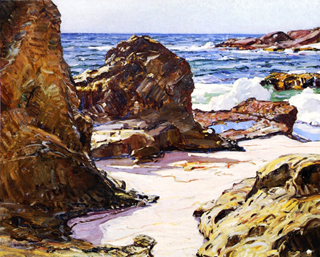
Rocks and Sea |
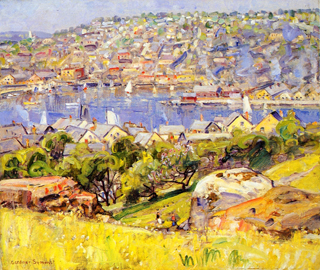
Fishing Village, St. Ives, Private Collection |
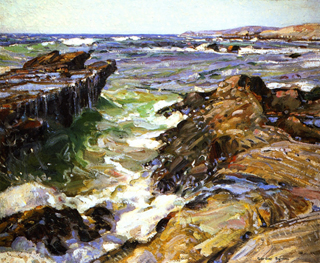
California Beach |
Today, Symons' works can be seen in many museums including the Brooklyn Institute of Arts and Sciences; the Art Institute of Chicago, and the Fleischer Museum in Scottsdale, Arizona. He was a member of numerous associations including the National Academy of Design, the National Arts Club, the Institute of Arts and Letters, the Lotos, Century, and Salmagundi Clubs. He was also a member of the Royal Society of British Artists and the Union Internationale des Beaux Arts et des Lettres.
|
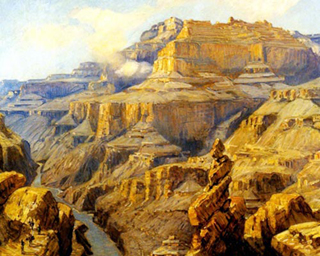
Grand Canyon |
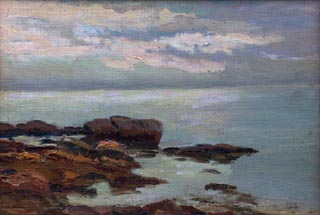
Seacoast, available through
Bodega Bay Heritage Gallery Collection |
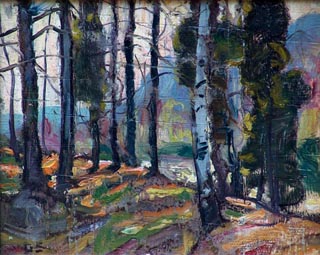
New England Forest, available through
Bodega Bay Heritage Gallery Collection |
| Back to the Top |
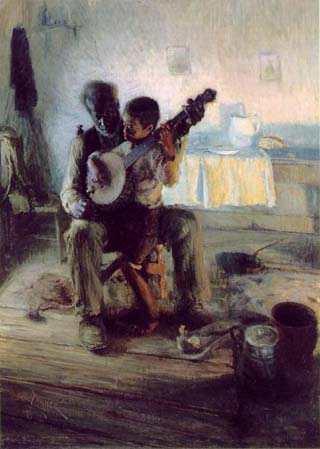
The Banjo Lesson
William and Camille Cosby Collection |
Henry did not marry until he was 40 years old. He married American opera singer Jessie Ollsen in 1899, and their son Jesse Ossawa Tanner was born in 1903. Henry was quite successful in France, able to own a home in Paris and a country getaway in Etaples, Normandy. He loved living in France. First and foremost, to live free of racial oppression and prejudice was a relief, but even more so for Henry was that his art was judged and accepted on its own right, with none of the baggage associated with race.
Back home in America, his success in France was noticed and celebrated.
|
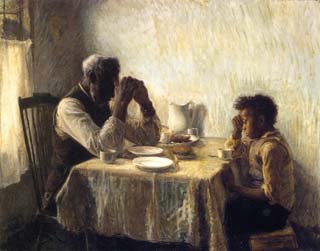
The Thankful Poor 1894
William and Camille Cosby Collection |
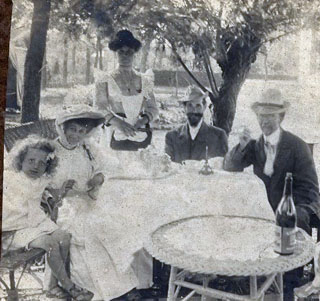
The Tanner Family in France |
Henry truly believed he could not fight racism and discrimination in America and still fulfill his artistic potential. Yet, he still managed to be a voice in America.
Booker T. Washington visited Henry in Paris and wrote about his success for American readers. His growing American fame brought exhibitions in Philadelphia, Boston, New York, Chicago, Washington, Pittsburgh, and St. Louis. In 1925, the African American journal The Crisis published a journal with a cover article of Henry Ossawa Tanner, W.E.B. Du Bois, Frederick Douglass, Samuel Taylor-Coleridge as models of African-American creative geniuses.
|
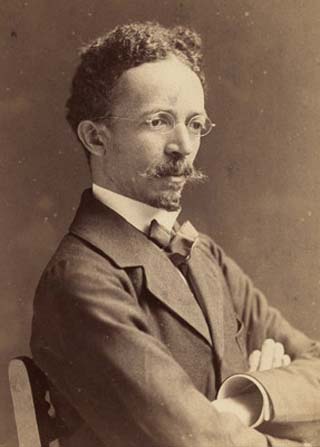
Henry Ossawa Tanner, Photo Portrait
Archives of American Art |
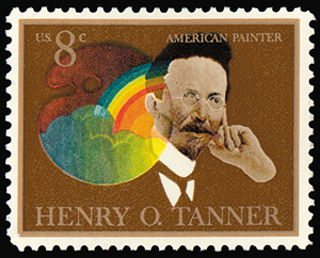
8 cent stamp, Henry Ossawa Tanner, issued Sept 10, 1973 |
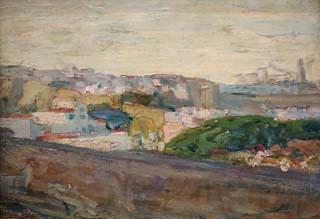
A view of Fez, 1912
High Museum Collection, Atlanta |
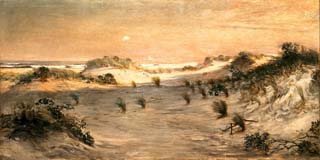
Sand Dunes at Sunset, Atlantic City, NJ,
White House Collection
acquired during President Clinton's Administration |
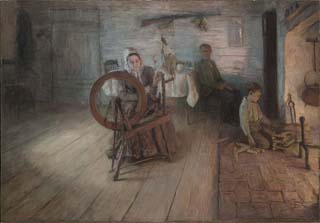
Spinning by Firelight, 1894
Yale University Art Gallery |
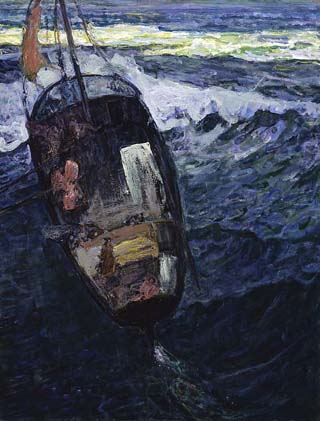
Fishermen at Sea
Smithsonian American Art Museum |
In 1893, most African Americans featured in paintings were caricatures or pitiful figures of poverty. Tanner rejected such treatments, choosing to represent black subjects with dignity. He wrote, "Many of the artists who have represented Negro life have seen only the comic, the ludicrous side of it, and have lacked sympathy with and appreciation for the warm big heart that dwells within such a rough exterior."
|
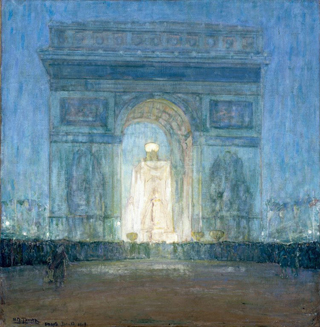
The Arch, Brooklyn Museum of Art |
His painting, The Banjo Lesson takes on this stereotyping head on. The banjo had become associated with slaves, a musical strumming instrument relic of Africa, now a cliche. But in Tanner's experienced and sensitive hand, he takes an older experienced man patiently and lovingly teaching a child to play. In so doing, he was providing powerful commentary about African American fathers as mentors and sages passing on the hard learned wisdom to the next generation. The Banjo Lesson was a large canvas and was accepted into the Paris Salon of 1894. The painting then came to America to the Hampton Institute near Norfolk, Virginia. From there it was loaned to Atlanta's Cotton States and International Exposition of 1895, hanging in the Negro Building.
But American critics ignored the work, seemingly blind to its strong imagery confronting a culturally accepted stereotype.
|
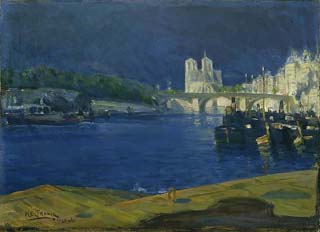
View of the Seine Looking Toward Notre Dame 1896
Michael Rosenfeld Gallery, New York City |
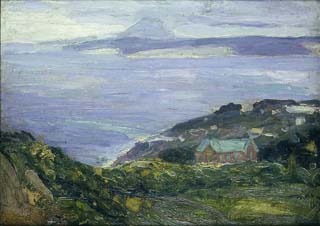
Coastal Landscape, France
Michael Rosenfeld Gallery, New York City |
Soon afterward, Tanner followed The Banjo Lesson with The Thankful Poor, but this effort also met with less than critical acceptance. At this point, Henry
gave up painting subjects depicting African Americans choosing instead to paint Biblical themed works. He returned to Paris and painted scenes for the Paris Salon or painted religious works.
|
The Smithsonian Site for Conversations, African and African American Art in Dialogue | Back to the Top |
| Gallery News |
Our Gallery Hours are from 12:00 P.M. to 4:00 P.M., Wednesday through Sunday. We are also available for scheduled appointments, especially for those who wish to view the gallery on Mondays or Tuesdays. Please call Dan at the gallery and schedule a visit, or call him on his cellphone, 510-414-9821
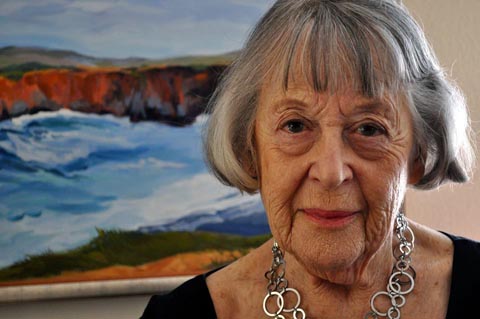 |
Bodega Bay artist
Florence Brass 1921 - 2014
We have lost a treasure! Florence passed away peacefully in her home on November 6, 2014 at the age of 93. Born in Weehawken, New Jersey in 1921, her talent as an artist led to a successful career as an advertising executive in New York City that spanned over five decades. When she moved to Bodega Bay in 1992, she retired from the ad business, returned to being a professional artist and became a partner in the Local Color Art Gallery. At the age of 93, she was still painting. An inspiration to many, she filled her life with work, artistry and the people she loved.
|
Florence is survived by her sons Bob and Jim Tischler, daughters-in-law Susan Head and Judith Tischler, granddaughter Rose Morris and her husband Zachary, grandson Zeke Tischler and his wife Brigette, niece Reina Delbos and her husband Phil and great granddaughter Marsella Morris.
There will be a celebration of Florence's life on Sunday, December 7th at 2:00 p.m. at the Sebastopol Community Cultural Center Annex, 425 Morris Street, Sebastopol, CA. See Florence's page on our site.
|
 |
Jean Warren:
A Fall Show of Watercolors
through January 4, 2015
Christopher Creek Winery
641 Limerick Ln, Healdsburg, 10-5 daily
Reception- Sunday, December 7, 3- 6pm
|
Hole in the Head:
The Battle for Bodega Bay
and the Birth of the Environmental Movement
Nov 2 - Feb 9
Now at the Sonoma County Museum,
425 Seventh St., Santa Rosa, CA 707-579-1500
|
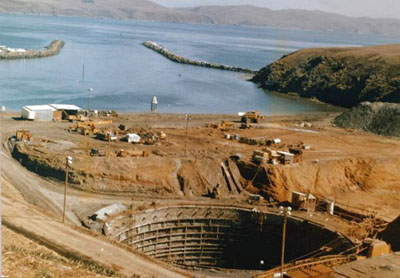
IT ALMOST HAPPENED ... half a century ago ...
The foundation for the Bodega Bay Nuclear Power Plant reactor
being built on Bodega Head ... today, our famous Hole in the Head |
The exhibition chronicles the story of the nuclear power plant, proposed for construction at Bodega Head in 1958 and its defeat by members of the local community in 1964. Stories will focus on the lives of the individuals involved in the struggle against PG&E and the arguments made against the plant on one of California’s most pristine coastal areas. This project not only honors the region’s earliest environmental activists but shows their enduring legacy for our region.
|
The project will include an in-gallery exhibition featuring text, photographs, artifacts and multimedia—mostly in the form of edited video interviews. The interviews will include new video collected for this project, as well as edited segments from a rich collection of existing video histories in SCM’s collection. (Click to See the article in the Press Democrat)
|
Follow us on Facebook ...
Bodega Bay Heritage Gallery
In mid-July, we began publishing our
Art Moment of the Day.
To the right is our Art Moment for
Saturday, November 29
Lightening strikes ... A young upstart meets an older failed painter at Le Chat Noir in Monmarte. They discuss color theory, strokes, method and technique while sipping absinthe. A brief friendship is born, a fiery moment in their all too brief lives. The upstart, Henri de Toulousse-Lautrec then quickly dashes off a portrait of his friend, Vincent Van Gogh.
You may view all our past Art Moments
on our archives page.
http://bbhgallery.com/BBHGallery_Archives.htm
When looking at our FB posts, please ...
Like / Comment / Share (especially share)
the resulting Buzz helps!
|
|
|
| Back to the Top |
| What's showing in Bodega Bay? |
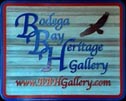 |
Bodega Bay Heritage Gallery
1785 Coast Highway One, Bodega Bay, CA 94923, 707-875-2911 | Map & Location
Celebrating Early California Art
- original paintings by famous artists of the past - and local artists
Vineyards, Orchards, Ranches & Farms
|
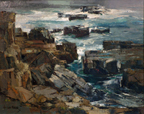
"Composed by the Ocean"
Joshua Meador
|
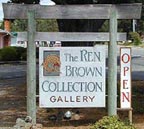 |
The Ren Brown Collection
"One Ocean One Voice"
Mayumi Oda ...
silkscreen prints and recent paintings through Nov 9
http://www.renbrown.com | Back to the Top
|

|
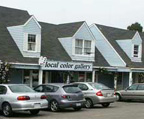 |
Alas no more ... A salute to our friends and good neighbor
Local Color Artist Gallery
They've closed their doors October 8,
"Thank you to all of our patrons and collectors through the years."
Back to the Top
Special note ... A Memorial Service for Florence Brass will be held
at the Sebastopol Community Center Annex, Sunday, December 7, 2:00 PM
|
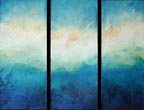 |
What's showing nearby?
in Sonoma, Napa & Marin Counties |
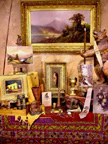 |
IN DUNCANS MILLS Christopher Queen Galleries
3 miles east of Hwy 1 on Hwy 116 on the Russian River
"The Traveling Painters" Bart Walker, Paul Kratter, & Sergio Lopez
http://www.christopherqueengallery.com |707-865-1318| Back to the Top |
 |
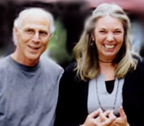 |
IN DUNCANS MILLS Quercia Gallery
"Infinite" -- paintings by Ron Quercia, Sep 1 - Dec 29
Hours: 11am-5pm, Thur - Mon (707) 865-0243
http://www.quercia-gallery.com | Back to the Top
|
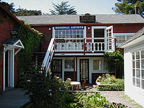 |
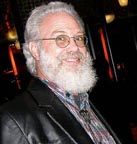 |
NOW IN SANTA ROSA Calabi Gallery | http://www.calabigallery.com
456 Tenth Street, Santa Rosa, CA 95401 | email: info@calabigallery.com | 707-781-7070
Famed master conservator Dennis Calabi brings his rare knowledge and experience
to present a tasteful and eclectic array of primarily 20th century artwork.
http://www.calabigallery.com | Back to the Top |

Easton, Crustacean Dancing Dream, American Alabaster |
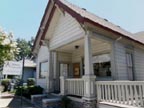 |
IN Santa Rosa The Annex Galleries
specializing in 19th, 20th, and 21st century American and European fine prints
The Annex Galleries is a member of the International Fine Print Dealers Association (IFPDA).
http://www.AnnexGalleries.com | Back to the Top |
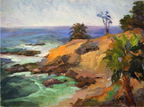 |
IN GRATON Graton Gallery
http://www.gratongallery.com
Graton Gallery | (707) 829-8912 | artshow@gratongallery.com
9048 Graton Road, Graton CA 95444 | Open Wednesday ~ Saturday 10:30 to 6, Sunday 10:30 to 4
|
 |
 |
IN BODEGA Bodega Landmark Gallery Collection
17255 Bodega Highway Bodega, California USA 94922 Phone 707 876 3477
http://www.artbodega.com | Lorenzo@ArtBodega.com | Back to the Top |
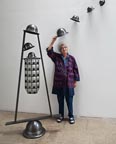 |
IN Healdsburg Hammerfriar Gallery
http://www.hammerfriar.com
(707) 473-9600 | Jill@hammerfriar.com
132 Mill Street, Healdsburg, CA 95448 | Open Tues - Fri 10 to 6, Sat 10 - 5, Sun 12 - 4
|
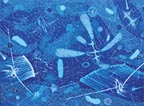 |
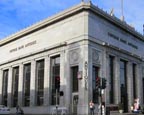 |
IN PETALUMA Vintage Bank Antiques
Vintage Bank Antiques is located in Historic Downtown Petaluma, corner of Western Avenue and Petaluma Blvd. It is listed on the National Register of Historic Places. Warren Davis and the rest of the team at Vintage Bank Antiques has assembled a spectacular inventory of paintings. From the 18th Century to Contemporary Artists. We have paintings to suit every price point and collector level.
If you have a painting for sale, please consider Vintage Bank Antiques. Contact Warren Davis directly at WarrenDavisPaintings@yahoo.com, 101 Petaluma Blvd. North, Petaluma, CA 94952, ph: 707.769.3097
http://vintagebankantiques.com | Back to the Top |
 |
IN PETALUMA Petaluma Art Center
"... to celebrate local artists and their contributions and involve the whole community
|

Petaluma Art Center
Photo:Anita Diamondstein |
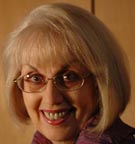
Lee Youngman |
IN CALISTOGA the Lee Youngman Gallery
Featuring the work of contemporary painter Paul Youngman,
and the works of famed painter, Ralph Love (1907-1992)
http://www.leeyoungmangalleries.com | Back to the Top
Left ... Lee Youngman, Right ... Paul Youngman |
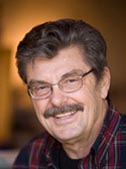
Paul Youngman |
| Links to current museum exhibits relevant to Early California Art |
| The Greater Bay Area |
The Walt Disney Family Museum
This museum tells Walt's story from the early days.
(on the Parade Grounds) 104 Montgomery Street,
The Presidio of San Francisco, CA 94129
"All Aboard: A Celebration of Walt's Trains
through Feb 9
-- view location on Google Maps -- |
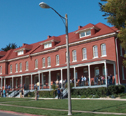 |
San Francisco
de Young Museum
Keith Haring: The Political Line
through Feb 16 |
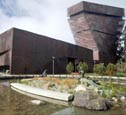 |
San Francisco
California Historical Society
Yosemite: A Storied Landscape
through Jan 25
|
 |
San Francisco
Legion of Honor
Houghton Hall:
Portrait of an English Country House
through Jan 18
Permanent European and Impressionist Paintings
|
 |
San Francisco
Contemporary Jewish Museum
|
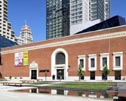 |
Oakland
Oakland Museum of California
Fertile Ground: Art and Community in California
through April 12
-- ongoing Gallery of California Art
-showcasing over 800 works from the OMCA's collection
|
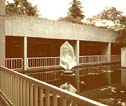 |
San Francisco
SFMOMA
Now ... More Open than ever ...
see our website
but closed for renovations
http://www.sfmoma.org/our_expansion |
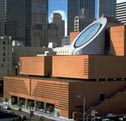 |
Santa Rosa
Sonoma County Museum
coming -- Nov 2 - Feb 8
Hole in the Head: The Battle for Bodega Bay and the Birth of the Environmental Movement |
 |
Santa Rosa
Charles M. Schultz Museum
"Peanuts in Wonderland" through April 26
|
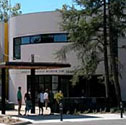 |
Moraga
Hearst Art Gallery
Pueblo to Pueblo:
The Legacy of Southwest Indian Pottery
Oct 12 through Dec 14 |
 |
Sonoma
Mission San Francisco de Solano Museum
featuring the famed watercolor paintings
of the California Missions
by Christian Jorgensen |
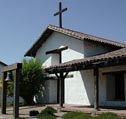 |
Sonoma
Sonoma Valley Museum of Art
551 Broadway, Sonoma CA 954
(707) 939-7862 |
 |
Ukiah
Grace Hudson Museum
Days of Grace:
California Artist Grace Hudson in Hawaii
through Dec 28
http://www.gracehudsonmuseum.org |
 |
Bolinas
Bolinas Museum
featuring their permanent collection,
including Ludmilla and Thadeus Welch,
Arthur William Best, Jack Wisby,
Russell Chatham, Alfred Farnsworth. |
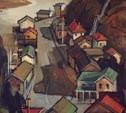 |
Walnut Creek
The Bedford Gallery, Lesher
Center for the Arts |
 |
San Jose
San Jose Museum of Art
approximately 2,000 20th & 21st
century artworks including paintings, sculpture,
new media, photography, drawings, prints, and artist books. |
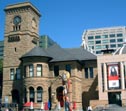 |
Monterey
Monterey Museum of Art
Warren Chang
through April 6
http://www.montereyart.org |
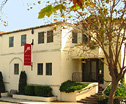 |
Palo Alto
Cantor Art Center at Stanford University
Rodin! The Complete Stanford Collection |
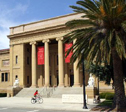 |
Sacramento
Crocker Art Museum
Our America: The Latino Presence in American Art
through Jan 11
& their marvelous Permanent Collection |
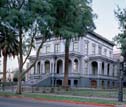 |
Sacramento
Capitol Museum
Governor's Portrait Gallery
Permanent Exhibits
(including one of our galllery's favorite artists,
Robert Rishell's portrait of Gov. Ronald Reagan) |
 |
Stockton's Treasure!
Time to visit & see The Haggin Museum!
-Largest exhibition of Albert Beirstadt paintings anywhere,
plus the works of Joseph Christian Leyendecker,
Norman Rockwell's mentor.
see our Newsletter article, April 2011
|
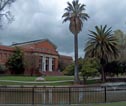 |
|
|
| Southern California (and Arizona) |
Los Angeles
Los Angeles Museum of Art
Art of the Americas, Level 3:
Artworks of paintings and sculptures
from the colonial period to World War II—
a survey of of art and culture
& "Levitated Mass" |
 |
Irvine
The Irvine Museum
Scenic View Ahead
The Westways Cover Art Program
through Jan 15 |
 |
Santa Barbara
The Santa Barbara Museum of Art
Degas to Chagall:
Important Loans from
The Armand Hammer Foundation
|
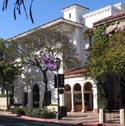 |
Palm Springs
Palm Springs Art Museum
Permanent Collection
American 19th century Landscape Painting
"A Grand Adventure" through Jan 4
an exhibition of a century of major Western painting including works by Bierstadt and Moran
and Dixon.
|
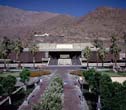 |
San Diego
San Diego Museum of Art
Permanent Collection |
 |
Pasadena
The Huntington Library
American Art Collection
Paintings by John Singer Sargent,
Edward Hopper, Robert Henri,
Albert Bierstadt, Thomas Moran,
William Keith, Mary Cassatt,
Thomas Hart Benton and many more. |
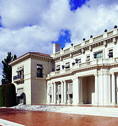 |
Pasadena
Norton Simon Museum
-Permanent collection,
European impressionist and post impressionist paintings
See our newsletter from March 2014 |
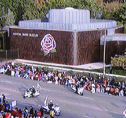 |
Pasadena
Museum of California Art
|
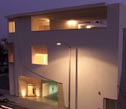 |
Prescott, AZ
Phippen Museum
Architecture in Art
through July 13
|
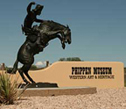 |
|
|
| & Beyond |
Seattle, WA
Seattle Art Museum |
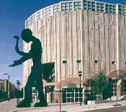 |
Portland, OR
Portland Art Museum
Permanent Collection: American Art |
 |
Washington D.C.
The Renwick Gallery
Permanent ... Grand Salon Paintings
from the Smithsonian American Art Museum |
 |
Chicago, IL
Art Institute of Chicago
Permanent collection:
the Impressionists |
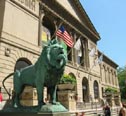 |
Cedar Rapids, IA
The Cedar Rapids Museum of Art
Grant Wood: In Focus
is an ongoing permanent collection exhibition. |
 |
Bentonville, AR
Crystal Bridges
Museum of American Art
|
 |
Washington D.C.
The National Gallery
Permanent collection
American Paintings |
 |
Philadelphia , PA
The Philadelphia Museum of Art |
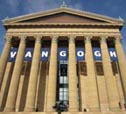 |
Philadelphia , PA
Barnes Foundation, Philadelphia Campus |
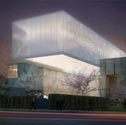 |
Brooklyn, NY
The Brooklyn Museum
American Art
Permanent Collection |
 |
New York , NY
The Whitney Museum of American Art
The largest selection of works by Edward Hopper |
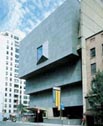 |
|
|


 Barge Captain
Barge Captain








 Indians Dancing
Indians Dancing





